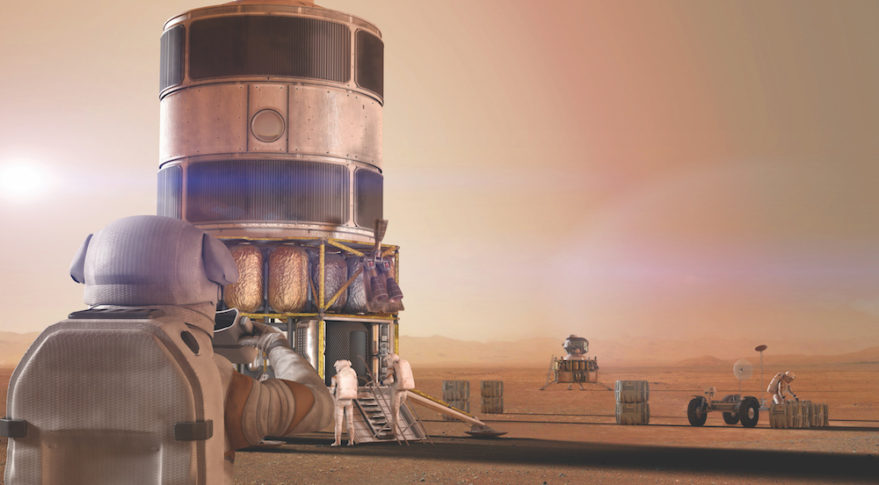Mars Mission Advocates See Benefits in NASA's Lunar Exploration Plans

WASHINGTON — With NASA committed to a human return to the moon, Mars exploration advocates say those lunar missions can be useful to achieve their long-term goals, if designed properly.
Many supporters of human missions to Mars had warned against spending resources on a human return to the moon, fearing that lunar surface expeditions would consume significant resources and delay exploration of Mars. Prior to the current administration's Space Policy Directive 1, NASA's "Journey to Mars" plans largely avoided the lunar surface, focusing instead on activities in cislunar space as a testing ground for Mars expeditions in the 2030s.
"[T]here was little or no support expressed for either demonstration programs with humans on the lunar surface nor for the search for usable resources to enable initial human missions to Mars," stated a report from a December 2016 workshop by Explore Mars and the American Astronautical Society on human Mars exploration. "Both were judged unnecessary, costly, and at present almost entirely devoid of sufficient engineering designs, trade studies, comparison with terrestrial supply, technology development plans that included launch vehicles in the lunar environment, and return on investment." [Astronauts Snap Amazing Last Glances of Space Station]
Under SPD-1, though, NASA is now committing to a presence, potentially for the long term, on the lunar surface. The agency is beginning studies of lunar lander designs, including large "human-class" landers needed for human missions to the lunar surface by the end of the next decade, in addition to the development of the Gateway facility that will operate in lunar orbit.
At a panel discussion Nov. 13 at the National Press Club here to discuss a 25-year timeline for getting humans to Mars, supporters of human missions to Mars now say that those lunar missions could help retire some of the technology risks associated with later Mars missions.
"I was actually skeptical of it, but there are significant crossovers," said Rick Davis, assistant director for science and exploration in NASA's Science Mission Directorate. Those lunar missions, he said, could address some of the technological challenges or "long poles" for Mars, from power systems to habitats.
"You can buy down a lot of those long poles in a lunar campaign and get us to Mars much sooner than most people would probably think," he said.
Get the Space.com Newsletter
Breaking space news, the latest updates on rocket launches, skywatching events and more!
That change in mindset, he said later, is due to a better understanding of what technologies are needed for Mars. "We got really smart about what we need for Mars," he said. Going to the moon isn't a requirement for going to Mars, he noted, but if those missions will take place anyway for other reasons, "you can use the moon very creatively to enable Mars."
One example he cited is the development of rovers. While a lunar rover and a Martian rover would not be identical, they are similar "at the 70 or 80 percent mark," he said. "That is massive, and that is how you buy this down and make it possible." He noted, though, there are exceptions: the entry, descent and landing systems needed for Mars missions can't be effectively tested on the moon given the moon's lack of an atmosphere. [NASA's Exploration Mission 1: A Step-by-Step Return to the Moon in Pictures]
"The moon is the ultimate deep space — no Van Allen Belts — practice place in the solar system," said James Garvin, chief scientist at NASA's Goddard Space Flight Center and another panel participant. "What does the moon offer? It offers that proving ground and training experience to fix the systems so that they work for three years at Mars versus two weeks at the moon."
Garvin offered another example of how lunar missions could support later Mars exploration by arguing that, if resources like water ice can be extracted and used on the moon it will be even easier to do so on Mars. "I think the moon is linked to Mars," he said.
Davis emphasized the need for an "integrated" program that kept in mind the needs for later Mars missions while planning lunar missions. "We believe there are significant gains to be had, but you've got to manage it, because otherwise you can get bogged down and not press on to Mars," he said.
This story was provided by SpaceNews, dedicated to covering all aspects of the space industry.
Join our Space Forums to keep talking space on the latest missions, night sky and more! And if you have a news tip, correction or comment, let us know at: community@space.com.

Jeff Foust is a Senior Staff Writer at SpaceNews, a space industry news magazine and website, where he writes about space policy, commercial spaceflight and other aerospace industry topics. Jeff has a Ph.D. in planetary sciences from the Massachusetts Institute of Technology and earned a bachelor's degree in geophysics and planetary science from the California Institute of Technology. You can see Jeff's latest projects by following him on Twitter.










